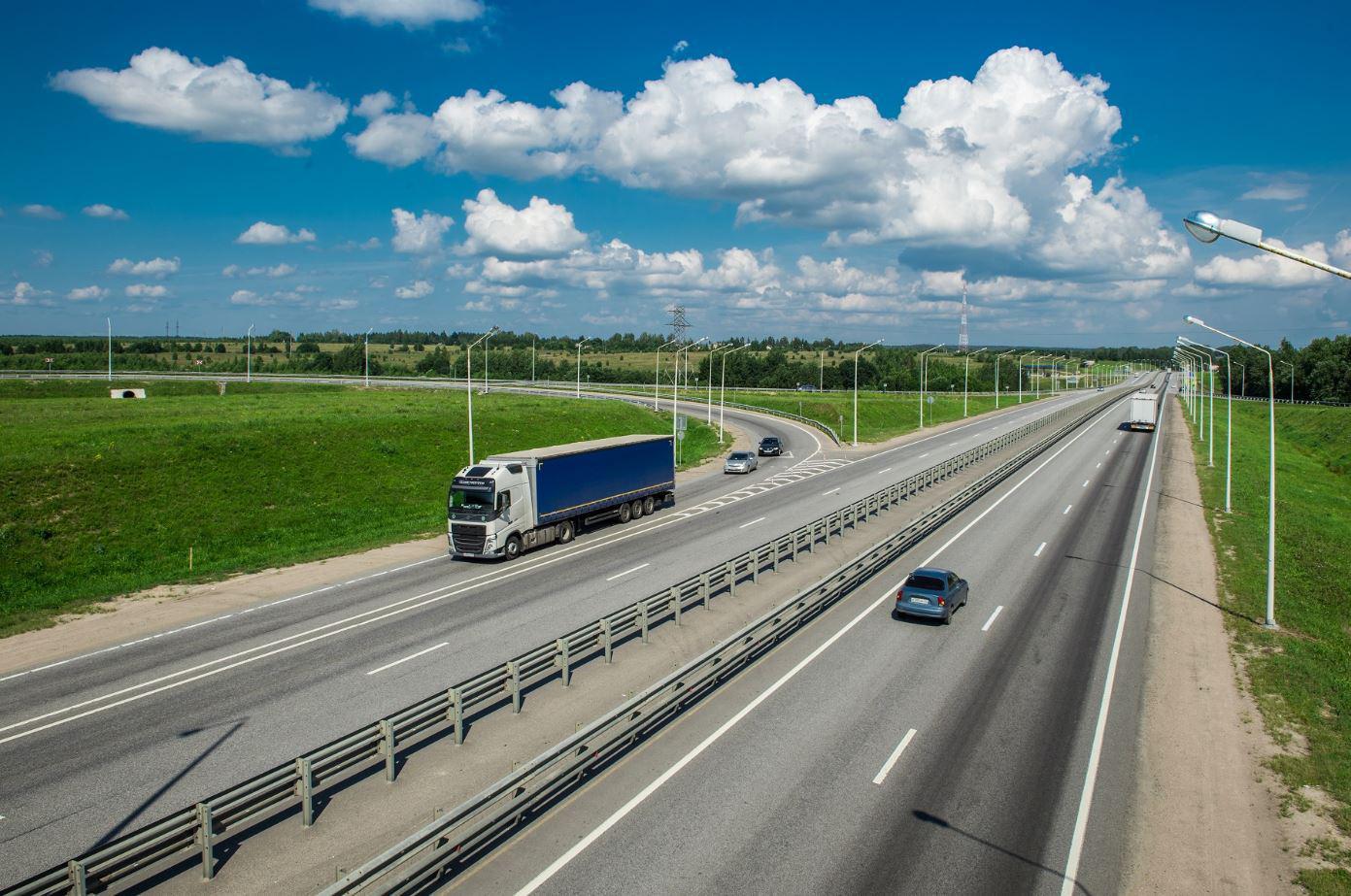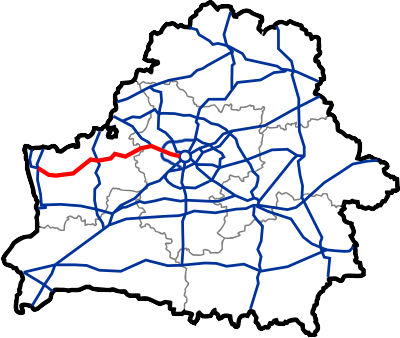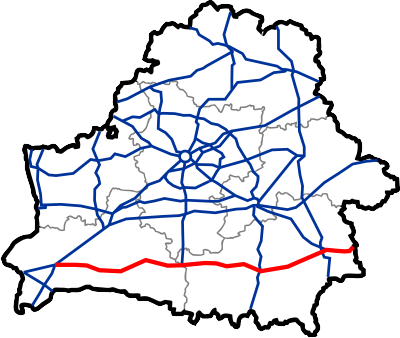Roads in Belarus
There are two types of roads in Belarus: republican and local. Republican roads are the most important routes that connect the main objects within the country, as well as lead to neighboring countries. Republican roads on the territory of Belarus are included in the network of international highways. They also connect Minsk with the administrative centers of the regions.

Republican roads include highways that connect the administrative centers of the regions with each other or lead to the National Airport. On the map, the letters “P” and “M indicate republican roads.
Local roads include other routes that connect cities and villages. These roads also go through forests, they do not always have an asphalt surface. On the map, local roads are marked with the letter “H".
All republican roads are owned by the state. Organizations and private companies own some of the local roads, so they may be closed to public use.
Main highways of Belarus

Motorways in Belarus belong to the main highways. They connect the main places of the country and lead to checkpoints on the border of Belarus. Motorways are designated by the letter “M". There are 13 of them in total. Seven motorways are also part of European routes.
M1 Motorway
The M1 motorway is the main transit road in Belarus. Its length is 611 km. The motorway begins in Brest on the border with Poland, passes through the territory of the Brest, Minsk and Vitebsk regions to the border with Russia in Red'ki village.

The speed limit on different sections of the motorway is 90-120 km/h. It is also the only highway in Belarus, which is toll throughout all the length.
The M1 highway is part of the European route E30, which runs from Ireland to Russia. It is also part of the Pan-European Transport Corridor network.
M2 Motorway
The M2 motorway connects Minsk and the Minsk National Airport. The road starts from the Minsk Ring Road M9, goes east to the Mound of Glory and turns to the airport.

The length of the motorway is 34 km. The entire length of the road is illuminated and has 4 lanes for traffic.
M3 Motorway

The M3 highway connects Minsk with Vitebsk. The road starts from the intersection of Lahojski trakt street with the Minsk Ring Road M9. Then it follows to the northeast to Vitebsk. The route takes 254 km.
M4 Motorway

The M4 motorway leads from Minsk to Mogilev. The route starts from the intersection of Partyzanski praspekt street with the M9 motorway and goes south-east via Smilovichi and Bialynicy to Mogilev. The length of the motorway is 182 km.
M5 Motorway
The 282 km route connects Minsk with Gomel. The road branches off from the M4 motorway near Privolnyi city, passes by Maryina Gorka and Zhlobin to Gomel. The motorway has 4 lanes. Speeds of up to 120 km/h are allowed on some sections.

The M5 motorway is part of the European automobile route E271, which only runs across Belarus. Route E271 completely repeats the M5 motorway.
M6 Motorway
The M6 motorway connects Minsk with Grodno. The road starts from the intersection of Prytyckaha Street with the Minsk Ring Road M9. Following west through Valozhyn and Lida, the motorway leads to Grodno. Part of the road from Minsk to Valozhyn repeats the M7 motorway.

The length of the M6 motorway is 262 km. It is also part of the European route E28 connecting Minsk with Berlin.
M7 Motorway
The M7 highway starts in Minsk, passes through Ashmyany and leads to the Kamenny Log checkpoint on the border with Lithuania. The length is 139 km. The motorway has 2 lanes for traffic along the entire length, one in each direction.
The route starts at the Minsk Ring Road. It coincides with the M6 motorway till Valozhyn, then goes northwest. The M7 motorway is also a part of the E28 highway.
M8 Motorway
The M8 highway leads from the border with Russia to the border with Ukraine. It begins at the border with Russia (Jeziarysca checkpoint), passes through Vitebsk, Mogilev, Gomel and ends at the border with Ukraine (Novaya Guta checkpoint). The length of the entire route is 465 km. The motorway has two stripes.

The European route E95 also runs along the highway, which leads from Russia to Turkey through Ukraine and Belarus.
M9 Motorway
The M9 motorway is the first Minsk ring road. The motorway runs along the administrative border of Minsk and occupies 56 km.

This is a first class road with six lanes. There is lighting throughout the route, as well as no traffic lights, intersections and left turns. The capacity of the road is 85 thousand cars per day. The estimated speed on the ring road is 120 km/h.
M10 Motorway
The Belarusian M10 motorway begins in Gomel, passes through 14 settlements and ends in Kobrin (Brest region). The length of the highway is 526 km. The first 50 km from Gomel, the road has 4 lanes. Then it narrows into 2 lanes and stretches to the final destination.

The road partially passes through woodlands, where there are no barrier nets. During the trip, it is recommended to keep high attention, since wild animals can cross the highway.
M11 Motorway
The M11 motorway begins at the border of Belarus with Lithuania at the Benyakoni checkpoint in the Grodno region. The motorway ends in Byten' village, Brest region, at the intersection with the M1 highway.

The length of the M11 motorway is 185 km. It is also part of the European route E85, which leads from Lithuania to Greece.
The road has 2 lanes. It expands into 4 lanes on some intersections.
M12 motorway
The M12 motorway begins in Kobrin and leads to the border with Ukraine at the Mokrany checkpoint. The route takes 254 km. Like the M11, the M12 road is a part of the E85 Europe highway. The road has 2 lanes for traffic, one in each direction.
M14 Motorway
The M14 highway is the second ring road around Minsk, which was opened in December 2016. The total length of the route is about 160 km. The second ring road is located at a distance of up to 22 km from the first ring road.
Most of the road is built using German technology, and frrom the 37th to the 46th kilometer it is American. There is also an experimental section from the 28th to the 32nd kilometer.

The estimated speed on the M14 highway is 120 km/h. According to the plan, the road has a capacity in 20 thousand cars daily.
Traffic rules on motorways in Belarus
In Belarus, a motorway is marked with the road sign “Motorway”.

On motorways, it is prohibited:
- traffic of pedestrians, animal-drawn vehicles, horseback riders, drivers of cattle, traffic on cycles, mopeds, wheeled tractors, self-propelled machines and vehicles which due to technical reasons cannot move with a speed higher than 40 km/h.
- In addition, it is prohibited to have vehicles standing outside areas intended for parking, marked with road signs “Parking”, “Rest site”.


- It is also prohibited to make U-turn and to enter the dividing strip gaps, except for the places marked with road signs “U-turn”, “U-turn area”.


- On motorways, it is prohibited to travel in reverse;
- to tow a power-driven vehicle (when it is being evacuated it is necessary to leave the motorway at the closest exit);
- to train driving a power-driven vehicle.
For motor vehicles and trucks with technically permissible total of not more than 3.5 tons allowed speed is no more than 110 km/h on motorways. For buses, cars and trucks, when they travel with a trailer, trucks with technically permissible total mass of over 3.5 tones, the speed should be not more than 90 km/h on motorways.
Toll Roads in Belarus
There are 12 toll roads in Belarus, including 7 motorways. You can find a map of toll roads here.
The first way to pay for travel is through a special radio device that is attached to the windshield of the car. When a vehicle passes under metal portals installed on all toll roads, the system automatically debits funds from the device account. The account is created when the user registers in the system. You can register and get the device at BelToll points, which are located near road border crossings, along the toll roads themselves and in all region centers in Belarus.

There is another simpler way to pay for travel on toll roads in Belarus — an electronic vignette. It gives the right to use the toll road during the period for which the fare is paid. After purchasing an electronic vignette, all data gets into the BelToll system, which automatically monitors the user's compliance with the fare payment procedure.
Toll roads tariffs in Belarus
Tariffs on toll roads depend on the type of vehicle. As of July 2022, the minimum tariff for vehicles with a permissible total weight of up to 3.5 tons is 0.040 EUR/km. The maximum fare is 0.145 EUR/km.
All vehicles with a technically permissible total weight of more than 3.5 tons are required to pay for travel on toll roads on the territory of Belarus. As well as vehicles with a technically permissible total weight of no more than 3.5 tons, not registered in the territory of the member states of the Eurasian Economic Union. However, there are exceptions.
Users of the vehicles below are exempt from toll charges in Belarus:
- vehicles registered in the territory of the member states of the Eurasian Economic Union (EEU) or with temporary license plate numbers of the Republic of Belarus installed in cases provided for by the applicable laws. With the maximum laden weight not exceeding 3.5 tones, as well as trailers towed by them;
- vehicles with the maximum laden weight not exceeding 3.5 tones registered outside the territory of EEU member states, imported by natural persons into EEU customs area or acquired by natural persons in the territory of EEU member states and imported into the territory of the Republic of Belarus. And trailers towed by such vehicles, – within 10 days from the date they are released by the customs authorities for circulation in the EEU customs area without restrictions on their use and disposal, or from the date of their acquisition, respectively;
- vehicles with temporary (transit) license plate numbers issued in a foreign state acquired by individual entrepreneurs or legal entities of the Republic of Belarus for ownership, economic management or operational control and imported into the territory of the Republic of Belarus;
- motorbikes and motorcycles;
- wheeled tractors and self-propelled vehicles registered in the territory of the Republic of Belarus;
- special operations vehicles;
- route vehicles used for urban transportation of passengers, as well as emergency response vehicles or vehicles used for transporting humanitarian aid cargo for the population of the Republic of Belarus and other countries;
- vehicles used for defense and law enforcement purposes.
Follow us on Facebook, LinkedIn!
Photo: brest.biz



 Back
Back

